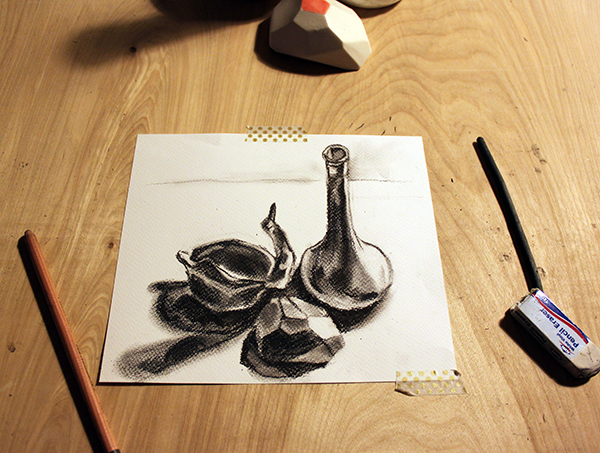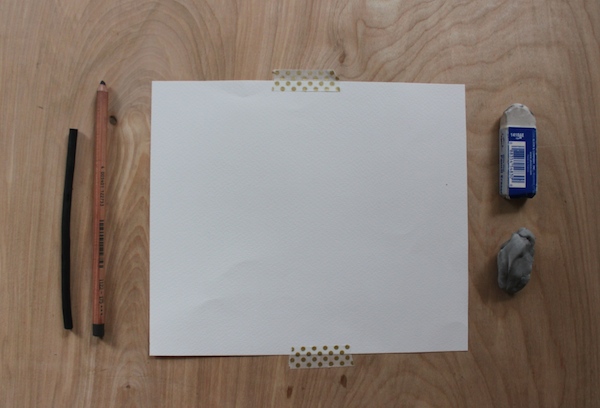So, you want to draw realistically and give the objects you render the feeling that they have some “oomph.” An easy way to do this is through drawing shadow mass. It makes even the heaviest vase or fluffiest pillow look like it’s sitting on something rather than just floating in space.

This tutorial will show you how to effectively work with shadows.
Before we begin, let’s make a small still life. Pick out a few objects that you like. I’ve selected some of my favorite ceramics. Make sure it’s something that you’ll want to draw, and it helps if you know it well. These objects sit on my night stand, so I look at them everyday.
In this tutorial, lighting is important. It’s up to you the how it’s done (from a lamp, for instance), but make sure that your objects are well lit. What will probably work best is a strong light from a single source that casts a long shadow.
I use a combination of vine (soft) and compressed (hard) charcoal. I work soft to hard, starting with vine and ending with compressed.
Here’s what I’m drawing with today.

- Vine charcoal: This is a soft type of charcoal that’s perfect for light sketching and is the easiest to manipulate.
- Kneaded eraser: Not your average eraser, this is specifically made for drawing. It’s very malleable, and you can stretch it like Silly Putty™. I use it for blending, too.
- Drawing paper: You can use whatever kind you like. Here, I’m drawing on paper that has a “tooth” that will hold the medium in place.
- Charcoal pencil: This is a hard type of charcoal, great for dark shadows and outlines. It’s harder to smudge (and to erase) and is typically used at the end of the drawing.
- Conventional white eraser: This is for completely cleaning up lines, or when you need to start over.
Step 1: Begin with an outline.

I always begin with vine charcoal to draw an outline of my objects. Don’t worry about shading or getting the details perfect — this is just meant to give you a general start, so you can look at your composition and decide if you like it!
Because this tutorial focuses on drawing shadow mass, I’m not going to worry as much about the non-shaded parts. We’ll skip right to the good stuff, like the dark, rich tones of shading!
Step 2: Assess the shadows.

Drawing a shadow is all about figuring out the relationship between spaces. So, you’ll first need to figure out where they are and draw the shapes that you see. Don’t forget to look between objects. What kind of shadows do they cast on each other? What is the shape that’s made on the ground?
Step 3: Start shading!



Using your vine charcoal, start to color the entire shadow. We do this to give an overall tone to it. Blend the the medium into the paper and remember, shadows don’t always have rigid edges. They have a dark center that often gets lighter and forms blurry edges when it meets the light that’s bent around the object.
Step 4: Move on to condensed charcoal.


Once you’ve diffused the edges and colored in the lighter-shaded areas, it’s time to move on condensed charcoal. This is a less forgiving type of tool, but it will give you the rich blackness to the shadows. Look carefully to determine where the darkest parts are and copy the shapes you see. Once you’ve drawn them, start to color them in. Afterwards, smudge the edges as best you can to blend the compressed with the vine charcoal. That way, it will feel like one cohesive shadow. You might want to use the vine again to help combine these two areas better.
Step 5: Refine and define.

It never hurts to check over your work. After you’ve used the condensed charcoal, go back and assess your shadows. Add anything you might’ve missed or erase what shouldn’t be there. Use your white eraser to clean up edges, and don’t be afraid to use your fingers to blend areas and make them softer.
Charcoal, of course, can be messy, but it’s a lot of fun. This versatile medium will help you when drawing shadow mass to give your artwork a life of its own.
Learn more techniques for adding interest to your works as you take drawings from flat to fully dimensional with the Craftsy class The Art & Science of Perspective, and learn how to use charcoal to create portraits in stunning human likeness with the class Traditional Portrait Drawing Techniques.


Share tips, start a discussion or ask one of our experts or other students a question.
No Responses to “How to Draw Shadow Mass Using Charcoal”